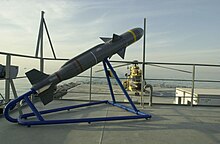Sea Skua
The Sea Skua is a British lightweight short-range air-to-surface missile (ASM) designed for use from helicopters against ships.
Although the missile is intended for helicopter use, Kuwait employs it in a shore battery and on their Umm Al Maradem (Combattante BR-42) fast attack craft.
Growing increasingly concerned about the threat of aircraft, especially after the introduction of glide bombs during the war, the Royal Navy was convinced that all ships required some form of surface-to-air missile (SAM) for defence.
These systems tended to be relatively large, especially in the era before vertical launch, and it was difficult to mount both a useful SAM and a conventional gun on smaller ships.
This led to a series of experiments to produce a dual-use missile capable of both anti-air and anti-ship use, thereby removing the need for a gun.
This led to the Small-Ship Guided Weapon and ultimately to Sea Dart, which was tested in the anti-shipping role against a Brave-class patrol boat.
The sinking of the Eliat in 1967 led to the realization that small fast-attack boats carrying medium-range anti-shipping missiles were a serious immediate threat.
A weapon was needed that could destroy any such craft before it could approach within the launching range of its missiles, which was longer-ranged than any light gun.
A new dedicated anti-shipping missile could fill the role, but it would have to be roughly the same size as those being aimed against it in order to reach the required range, which would make it take up too much room on a ship carrying many other weapons systems.
As it approaches the pre-programmed location of the target, the missile climbs to a higher altitude in order to acquire the radar signal for final homing.
[3] The illuminating radar aboard Lynx helicopters is the Seaspray, developed by Ferranti, now GEC, specifically for this role.
[3] In addition to serving with the United Kingdom, the Sea Skua has been exported to Germany (where it will be replaced from 2012 onwards), India, Kuwait and Turkey.
[4] Sea Skuas were launched eight times during the Falklands War, sometimes in extremely bad weather, and scoring a very high hit rate.
[6] Extensive damage was inflicted and eight crewmen (including the captain) were killed, but the ship was not sunk and returned to Puerto Deseado.
The remaining vessels were damaged, destroyed or dispersed by American carrier-based aircraft and Royal Navy Sea King helicopters.
The next day, another convoy of three Polnocny class landing ship, three TNC-45 fast attack craft (taken over by Iraq from the Kuwaiti Navy) and a single T43-class minesweeper, was detected in the same area.
On 16 March 2006, the Royal Malaysian Navy test-fired the Sea Skua missile as part of a contractual Firing exercise.
The Royal Malaysian Navy ordered Matra Bae Dynamics (MBDA) to take back the missiles to conduct system checks and re-tested.




